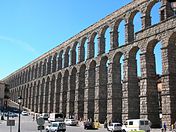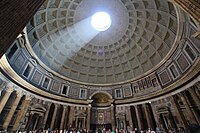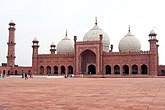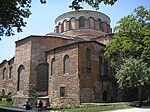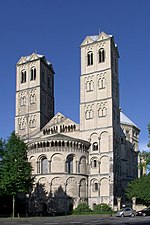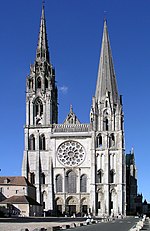The history of architecture traces the changes in معماری through various traditions, regions, overarching stylistic trends, and dates.


Neolithic architecture is the architecture of the دوران نوسنگی period. In Southwest Asia, Neolithic cultures appear soon after 10000 BC, initially in the شام (سرزمین) (Pre-Pottery Neolithic A and Pre-Pottery Neolithic B) and from there spread eastwards and westwards There are early Neolithic cultures in Southeast Anatolia, Syria and Iraq by 8000 BC, and food-producing societies first appear in southeast Europe by 7000 BC, and Central Europe by c. 5500 BC (of which the earliest cultural complexes include the Starčevo-Koros (Cris), Linearbandkeramic, and Vinča). With very small exceptions (a few copper تیشهs and نیزه heads in the Great Lakes region), the people of the قارههای آمریکا and the Pacific remained at the Neolithic level of فناوری up until the time of European contact.
The neolithic peoples in the شام (سرزمین), آناتولی, سوریه, northern میانرودان and آسیای مرکزی were great builders, utilizing mud-brick to construct houses and villages. At Çatalhöyük, houses were plastered and painted with elaborate scenes of humans and animals. The Mediterranean neolithic cultures of مالت worshiped in megalithic temples.
In Europe, دوران نوسنگی built from wattle and daub were constructed. Elaborate tombs for the dead were also built. These tombs are particularly numerous in Ireland, where there are many thousands still in existence. Neolithic people in the British Isles built long barrows and chamber tombs for their dead and causewayed camps, henges flint mines and cursus monuments.
Ancient Mesopotamia
این بخش مقاله نیازمند گسترش است. |
Ancient Egyptian architecture

In مصر باستان and other early societies, people believed in the omnipotence of Gods, with many aspects of daily life were carried out with respect to the idea of the divine or فراطبیعی and the way it was manifest in the mortal cycles of generations, years, seasons, days and nights. Harvests for example were seen as the benevolence of fertility deities. Thus, the founding and ordering of the city and her most important buildings (the کاخ or معبد) were often executed by priests or even the ruler himself and the construction was accompanied by آیین intended to enter human activity into continued divine benediction.
Ancient architecture is characterized by this tension between the divine and mortal world. Cities would mark a contained sacred space over the wilderness of طبیعت outside, and the temple or palace continued this order by acting as a house for the gods. The architect, be he کشیش or شاه (واژه), was not the sole important figure; he was merely part of a continuing tradition!
Classical architecture
Greek architecture

The architecture and urbanism of the یونان باستان and روم باستان was very different from that of the مصر باستان and هخامنشیان. Civic life gained importance for all members of the community. In the time of the ancients religious matters were only handled by the ruling class; by the time of the Greeks, religious mystery had skipped the confines of the temple-palace compounds and was the subject of the people or polis.
Greek civic life was sustained by new, open spaces called the آگورا which were surrounded by public buildings, stores and temples. The agora embodied the new found respect for social justice received through open debate rather than imperial mandate. Though divine wisdom still presided over human affairs, the living rituals of ancient civilizations had become inscribed in space, in the paths that wound towards the acropolis for example. Each place had its own nature, set within a world refracted through myth, thus temples were sited atop mountains all the better to touch the heavens.
Roman architecture
The Romans conquered the Greek cities in Italy around three hundred years BCE and much of the Western world after that. The Roman problem of rulership involved the unity of disparity — from اسپانیا to یونان, Macedonian to کارتاژ — Roman rule had extended itself across the breadth of the known world and the myriad pacified cultures forming this ecumene presented a new challenge for justice.
One way to look at the unity of Roman architecture is through a new-found realization of theory derived from practice, and embodied spatially. Civically we find this happening in the Roman forum (sibling of the Greek agora), where public participation is increasingly removed from the concrete performance of rituals and represented in the decor of the architecture. Thus we finally see the beginnings of the contemporary public square in the Forum Iulium, begun by ژولیوس سزار, where the buildings present themselves through their facades as representations within the space.
As the Romans chose representations of sanctity over actual sacred spaces to participate in society, so the communicative nature of space was opened to human manipulation. None of which would have been possible without the advances of Roman مهندسی and construction or the newly found سنگ مرمر quarries which were the spoils of war; inventions like the تاق قوسی and بتن gave a whole new form to Roman architecture, fluidly enclosing space in taut گنبدs and colonnades, clothing the grounds for imperial rulership and civic order. This was also a response to the changing social climate which demanded new buildings of increasing complexity — the کولوسئوم, the residential block, bigger hospitals and academies. General civil construction such as roads and bridges began to be built.
The Romans widely employed, and further developed, the تاق قوسی, vault and گنبد (see the Roman Architectural Revolution), all of which were little used before, particularly in Europe.[1] Their innovative use of Roman concrete facilitated the building of the many public buildings of often unprecedented size throughout the امپراتوری روم. These include Roman temples, Roman baths, Roman bridges, Roman aqueducts, Roman harbours, triumphal arches, Roman amphitheatres, Roman circuses کاخs, آرامگاه and in the late empire also churches.
Roman domes permitted construction of vaulted ceilings and enabled huge covered public spaces such as the public baths like Baths of Diocletian or the monumental پانتئون (معبد رومی) in the city of Rome.
Art historians such as Gottfried Richter in the 1920s identified the Roman architectural innovation as being the تاق نصرت and it is poignant to see how this symbol of power on earth was transformed and utilized within the Christian basilicas when the Roman Empire of the West was on its last legs: The arch was set before the altar to symbolize the triumph of Christ and the after life. It is in their impressive آبگذر that we see the arch triumphant, especially in the many surviving examples, such as the Pont du Gard, the aqueduct at سگوبیا and the remains of the Aqueducts of Rome itself. Their survival is testimony to the durability of their materials and design.
Examples of key Roman architectural forms
تاق نصرت: Arch of Constantine, Rome
Dome: Interior of the پانتئون (معبد رومی) in Rome
Byzantine architecture
The امپراتوری روم شرقی gradually emerged as a distinct artistic and cultural entity from the Roman Empire after AD 330, when the Roman Emperor Constantine moved the capital of the Roman Empire east from Rome to بیزانتیوم (later renamed قسطنطنیه and now called استانبول). The empire endured for more than a millennium, dramatically influencing قرون وسطی and معماری رنسانس architecture in Europe and, following the capture of Constantinople by the امپراتوری عثمانی in 1453, leading directly to the architecture of the Ottoman Empire.
Early Byzantine architecture was built as a continuation of Roman architecture. سبک معماری, technological advancement, and political and territorial changes meant that a distinct style gradually emerged which imbued certain influences from the Near East and used the Greek cross plan in church architecture. Buildings increased in geometric complexity, brick and plaster were used in addition to stone in the decoration of important public structures, شیوههای معماری کلاسیک غربی were used more freely, معرقکاریs replaced carved decoration, complex domes rested upon massive piers, and windows filtered light through thin sheets of رخام گچی to softly illuminate interiors.
معماری اسلامی has encompassed a wide range of both secular and religious architecture styles from the foundation of Islam to the present day, influencing the design and construction of buildings and structures within the sphere of Islamic culture. Some distinctive structures in Islamic architecture are مسجدs, tombs, کاخs and forts, although Islamic architects have of course also applied their distinctive design precepts to domestic architecture.
The wide spread and long history of Islam has given rise to many local architectural styles, including معماری ایرانی, Moorish, Timurid, Ottoman, خلفای فاطمی, مملوکها, Mughal, Indo-Islamic, Sino-Islamic and Afro-Islamic architecture. Notable Islamic architectural types include the early Abbasid buildings, T-type mosques, and the central-dome mosques of Anatolia.
Various regional styles of medieval Islamic architecture, as show in religious structures (from west to east)
Sudano-Sahelian: The Great Mosque of Djenné in present-day Mali, illustrating the mud construction of western Africa.
Ottoman architecture: مسجد سلطان احمد, Istanbul, Turkey.
معماری ایرانی: مسجد شیخ لطفالله, Isfahan, Iran.
Mughal architecture: مسجد بادشاهی, Pakistan

Great Zimbabwe is the largest medieval city in sub-Saharan Africa. By the late nineteenth century, most buildings reflected the fashionable European eclecticism and pastisched Mediterranean, or even Northern European, styles.
In the Western Sahel region, Islamic influence was a major contributing factor to architectural development from the time of the Kingdom of Ghana. At کومبی صالح, locals lived in domed-shaped dwellings in the king's section of the city, surrounded by a great enclosure. Traders lived in stone houses in a section which possessed 12 beautiful mosques, as described by al-bakri, with one centered on نماز جمعه.[2] The king is said to have owned several mansions, one of which was sixty-six feet long, forty-two feet wide, contained seven rooms, was two stories high, and had a staircase; with the walls and chambers filled with sculpture and painting.[3]
Sahelian architecture initially grew from the two cities of جنه and تیمبوکتو. The Sankore Mosque in تیمبوکتو, constructed from mud on timber, was similar in style to the Great Mosque of Djenné. The rise of kingdoms in the West African coastal region produced architecture which drew on indigenous traditions, utilizing wood. The famed Benin City, destroyed by the Punitive Expedition, was a large complex of homes in coursed mud, with hipped roofs of shingles or palm leaves. The Palace had a sequence of ceremonial rooms, and was decorated with brass plaques.
Persian architecture
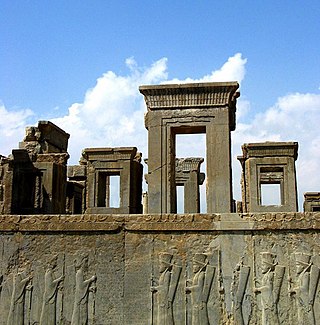
The pre-Islamic styles draw on 3-4 thousand years of architectural development from various civilizations of the Iranian plateau. The Islamic architecture of Iran in turn, draws ideas from its pre-Islamic predecessor, and has geometrical and repetitive forms, as well as surfaces that are richly decorated with glazed tiles, carved stucco, patterned brickwork, floral motifs, and calligraphy. As such, Iran ranks seventh in the world in terms of possessing historical monuments, museums, and other cultural attractions[4] and is recognized by UNESCO as being one of the cradles of civilization.[5]
Each of the periods of عیلامites, هخامنشیانs, اشکانیانns, and ساسانیانs were creators of great architecture that over the ages has spread wide and far to other cultures being adopted. Although Iran has suffered its share of destruction, including اسکندر's decision to burn تخت جمشید, there are sufficient remains to form a picture of its classical architecture.
The هخامنشیانs built on a grand scale. The artists and materials they used were brought in from practically all territories of what was then the largest state in the world. پاسارگاد set the standard: its city was laid out in an extensive park with bridges, gardens, colonnaded palaces and open column pavilions. Pasargadae along with Susa and Persepolis expressed the authority of The King of Kings, the staircases of the latter recording in relief sculpture the vast extent of the imperial frontier.
(in today عراق) - an example of معماری ساسانی during ساسانیان period.]]
With the emergence of the پارت and ساسانیانs there was an appearance of new forms. Parthian innovations fully flowered during the Sassanid period with massive barrel-vaulted chambers, solid masonry domes, and tall columns. This influence was to remain for years to come.
The roundness of the city of بغداد in the خلافت عباسیان era for example, points to its Persian precedents such as فیروزآباد in استان فارس.[6] The two designers who were hired by ابوجعفر عبدالله منصور to plan the city's design were Naubakht, a former Persian Zoroastrian who also determined that the date of the foundation of the city would be astrologically auspicious, and Mashallah, a former Jew from Khorasan.
The ruins of Persepolis, تیسفون, تمدن جیرفت,[7] تپه سیلک, پاسارگاد, فیروزآباد, ارگ بم, and thousands of other ruins may give us merely a distant glimpse of what contribution Persians made to the art of building.
The fall of the Sassanid Empire to invading Islamic forces ironically led to the creation of remarkable religious buildings in Iran. Arts such as خوشنویسی, stucco work, mirror work, and mosaic work, became closely tied with architecture in ایران in the new era. Archaeological excavations have provided sufficient documents in support of the impacts of Sasanian architecture on the architecture of the Islamic world. Many experts believe the period of Persian architecture from the 15th through 17th Centuries to be the most brilliant of the post-Islamic era. Various structures such as mosques, mausoleums, bazaars, bridges, and different palaces have mainly survived from this period.
In the old Persian architecture, semi-circular and oval-shaped vaults were of great interest, leading Safavi architects to display their extraordinary skills in making massive domes. In the words of D. Huff, a German archaeologist, the dome is the dominant element in Persian architecture. Domes can be seen frequently in the structure of بازارs and mosques, particularly during the Safavi period in Isfahan. Iranian domes are distinguished for their height, proportion of elements, beauty of form, and roundness of the dome stem. The outer surfaces of the domes are mostly mosaic faced, and create a magical view. Safavi اصفهان tried to achieve grandeur in scale (Isfahan's میدان نقش جهان is the 6th largest square worldwide) knowledge about building tall buildings with vast inner spaces. However, the quality of ornaments was decreased in comparison with those of the 14th and 15th centuries.
The great mosques of خراسان, Isfahan, and تبریز each used local geometry, local materials, and local building methods to express in their own ways the order, harmony, and unity of Islamic architecture. And thus when the major monuments of Islamic Persian architecture are examined, they reveal complex geometrical relationships, a studied hierarchy of form and ornament, and great depths of symbolic meaning.
Indian architecture

Indian architecture encompasses a wide variety of geographically and historically spread structures, and was transformed by the history of the شبهقاره هند. The result is an evolving range of architectural production that, although it is difficult to identify a single representative style, nonetheless retains a certain amount of continuity across history. The diversity of Indian culture is represented in its architecture. It is a blend of ancient and varied native traditions, with building types, forms and technologies from West and Central Asia, as well as Europe. Architectural styles range from Hindu temple architecture to معماری اسلامی to western معماری کلاسیک to معماری مدرن and معماری پستمدرن.
India's urban civilization is traceable to موهنجو دارو and هاراپا, now in Pakistan. From then on, Indian architecture and مهندسی عمران continued to develop, and was manifestated معبدs, کاخs and forts across the شبهقاره هند and neighbouring regions. Architecture and civil engineering was known as sthapatya-kala, literally "the art of constructing".
The temples of Aihole and پاتاداکال are the earliest known examples of Hindu temples. There are numerous Hindu as well as Buddhist temples that are known as excellent examples of Indian rock-cut architecture. According to J.J. O'Connor and E. F. Robertson,[8] the Sulbasutras were appendices to the وداها giving rules for constructing altars. "They contained quite an amount of geometrical knowledge, but the mathematics was being developed, not for its own sake, but purely for practical religious purposes."
During the شاهنشاهی کوشان and شاهنشاهی مائوریا, Indian architecture and civil engineering reached regions like Baluchistan and افغانستان. Statues of گوتاما بودا were cut out, covering entire mountain cliffs, like in تندیسهای بودا در بامیان, Afghanistan. Over a period of time, ancient Indian art of construction blended with Greek styles and spread to آسیای مرکزی. It includes the architecture of various dynasties, such as Hoysala architecture, Vijayanagara Architecture and Western Chalukya Architecture.
The Church of St. Anne which is cast in the Indian باروک Architectural style under the orientation of the most eminent architects of the time. It is a prime example of the blending of traditional Indian styles with western European architectural styles.

این بخش مقاله نیازمند گسترش است. |
این بخش مقاله نیازمند گسترش است. |
Architecture of the Khmer Empire
Indonesian architecture
Chinese architecture
From the Neolithic era Longshan Culture and عصر برنز era Erlitou culture, the earliest rammed earth fortifications exist, with evidence of timber architecture. The subterranean ruins of the palace at Yinxu dates back to the دودمان شانگ (c. 1600 BC–1046 BC). In historic China, architectural emphasis was laid upon the horizontal axis, in particular the construction of a heavy platform and a large roof that floats over this base, with the vertical walls not as well emphasized. This contrasts Western architecture, which tends to grow in height and depth. Chinese architecture stresses the visual impact of the width of the buildings. The deviation from this standard is the tower architecture of the Chinese tradition, which began as a native tradition[نیازمند منبع] and was eventually influenced by the بودیسم building for housing religious sutras — the stupa — which came from India. Ancient Chinese tomb model representations of multiple story residential towers and watchtowers date to the دودمان هان (202 BC–220 AD). However, the earliest extant Buddhist Chinese pagoda is the Songyue Pagoda, a 40 m (131 ft) tall circular-based brick tower built in استان هنان province in the year 523 AD. From the 6th century onwards, stone-based structures become more common, while the earliest are from stone and brick arches found in Han Dynasty tombs. The Zhaozhou Bridge built from 595 to 605 AD is China's oldest extant stone bridge, as well as the world's oldest fully stone open-spandrel segmental تاق قوسی.

The vocational trade of architect, craftsman, and engineer was not as highly respected in premodern Chinese society as the scholar-bureaucrats who were drafted into the government by the civil service examination system. Much of the knowledge about early Chinese architecture was passed on from one tradesman to his son or associative apprentice. However, there were several early treatises on architecture in China, with encyclopedic information on architecture dating back to the Han Dynasty. The height of the classical Chinese architectural tradition in writing and illustration can be found in the Yingzao Fashi, a building manual written by 1100 and published by Lie Jie (1065–1110) in 1103. In it there are numerous and meticulous illustrations and diagrams showing the assembly of halls and building components, as well as classifying structure types and building components.
There were certain architectural features that were reserved solely for buildings built for the Emperor of China. One example is the use of yellow roof tiles; yellow having been the Imperial color, yellow roof tiles still adorn most of the buildings within the Forbidden City. The معبد آسمان, however, uses blue roof tiles to symbolize the sky. The roofs are almost invariably supported by brackets, a feature shared only with the largest of religious buildings. The wooden columns of the buildings, as well as the surface of the walls, tend to be red in colour.
Many current Chinese architectural designs follow پسانوگرایی and western styles.
Korean architecture
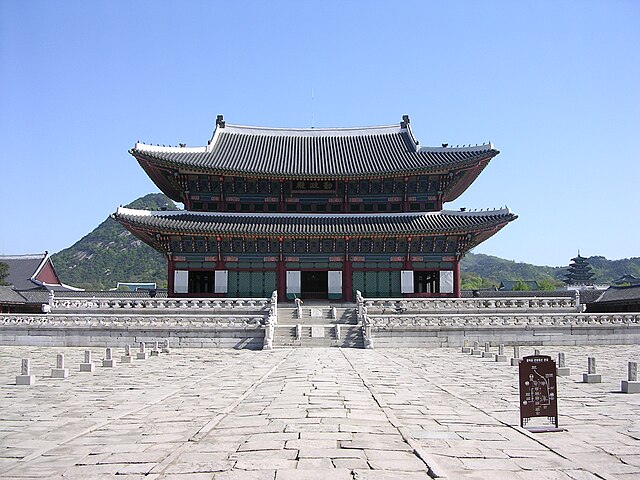
Korean architecture has a long history of 5,000 years[نیازمند منبع]. It has its own cultural identity different from Chinese or Japanese architecture. The basic construction form is more or less similar to Eastern Asian building system. From a technical point of view, buildings are structured vertically and horizontally. A construction usually rises from a stone subfoundation to a curved roof covered with tiles, held by a console structure and supported on posts; walls are made of earth (adobe) or are sometimes totally composed of movable wooden doors. Architecture is built according to the k'an unit, the distance between two posts (about 3.7 meters), and is designed so that there is always a transitional space between the "inside" and the "outside."
The console, or bracket structure, is a specific architectonic element that has been designed in various ways through time. If the simple bracket system was already in use under the Goguryeo kingdom (37 BCE–668 CE)—in palaces in Pyongyang, for instance—a curved version, with brackets placed only on the column heads of the building, was elaborated during the early Koryo dynasty (918–1392). The Amita Hall of the Pusok temple in Antong is a good example. Later on (from the mid-Koryo period to the early Choson dynasty), a multiple-bracket system, or an inter-columnar-bracket set system, was developed under the influence of Mongol's Yuan dynasty (1279–1368). In this system, the consoles were also placed on the transverse horizontal beams. Seoul's Namtaemun Gate Namdaemun, Korea's foremost national treasure, is perhaps the most symbolic example of this type of structure. In the mid-Choson period, the winglike bracket form appeared (one example is the Yongnyongjon Hall of Jongmyo, Seoul), which is interpreted by many scholars as an example of heavy Confucian influence in Joseon Korea, which emphasized simplicity and modesty in such shrine buildings. Only in buildings of importance like palaces or sometimes temples (Tongdosa, for instance) were the multicluster brackets still used. Confucianism also led to more sober and simple solutions.
Japanese architecture

Japanese architecture has as long a history as any other aspect of Japanese culture. Influenced heavily by Chinese and Korean architecture, it also shows a number of important differences and aspects which are uniquely Japanese.
Two new forms of architecture were developed in medieval Japan in response to the militaristic climate of the times: the دژ, a defensive structure built to house a feudal lord and his soldiers in times of trouble; and the shoin, a reception hall and private study area designed to reflect the relationships of lord and vassal within a feudal society.
Because of the need to rebuild Japan after World War II, major Japanese cities contain numerous examples of modern architecture. Japan played some role in modern آسمانخراش design, because of its long familiarity with the cantilever principle to support the weight of heavy tiled temple roofs. New برنامهریزی شهری ideas based on the principle of layering or cocooning around an inner space (oku), a Japanese spatial concept that was adapted to urban needs, were adapted during reconstruction. نوگرایی became increasingly popular in architecture in Japan starting in the 1970s.
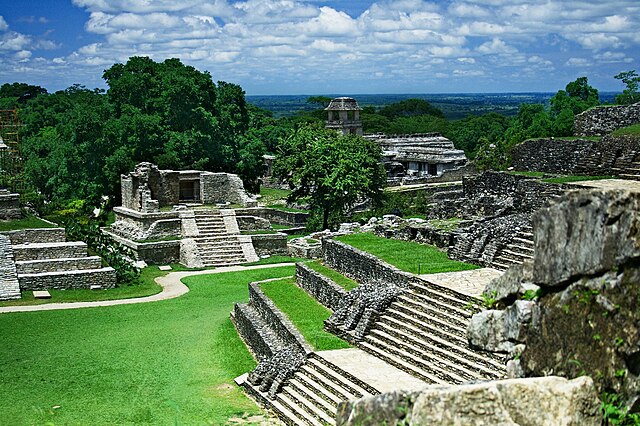
Mesoamerican architecture
Mesoamerican architecture is the set of architectural traditions produced by pre-Columbian cultures and civilizations of Mesoamerica, (such as the Olmec, معماری مایا, and Aztec) traditions which are best known in the form of public, ceremonial and urban monumental buildings and structures. The distinctive features of Mesoamerican architecture encompass a number of different regional and historical styles, which however are significantly interrelated. These styles developed throughout the different phases of گاهنگاری آمریکای مرکزی as a result of the intensive cultural exchange between the different cultures of the Mesoamerican culture area through thousands of years. Mesoamerican architecture is mostly noted for its pyramids which are the largest such structures outside of مصر باستان.
Incan architecture

Incan architecture consists of the major construction achievements developed by the امپراتوری اینکا. The Incas developed an extensive road system spanning most of the western length of the continent. Inca rope bridges could be considered the world's first suspension bridges. Because the Incas used no wheels (It would have been impractical for the terrain) or horses, they built their roads and bridges for foot and pack-لاما traffic. Much of present day architecture at the former Inca capital کوسکو shows both Incan and Spanish influences. The famous lost city Machu Picchu is the best surviving example of Incan architecture. Another significant site is Ollantaytambo. The Inca were sophisticated stone cutters whose masonry used no mortar.
Ancient architecture of North America

Inside what is the present-day United States, the Mississippians[9] and the Pueblo[10] created substantial public architecture. The تمدن میسیسیپی was among the mound-building peoples, noted for construction of large earthen platform mounds.
Impermanent buildings, which were often architecturally unique from region to region, continue to influence American architecture today. In his summary, "The World of Textiles", North Carolina State's Tushar Ghosh provides one example: the Denver International Airport's roof is a fabric structure that was influenced by and/or resembles the tipis of local cultures. In writing about Evergreen State College, Lloyd Vaughn lists an example of very different native architecture that also influenced contemporary building: the Native American Studies program is housed in a modern-day longhouse derived from pre-Columbian Pacific Northwest architecture.
Medieval architecture
Surviving examples of medieval secular architecture mainly served for defense. دژs and fortified walls provide the most notable remaining non-religious examples of medieval architecture. Windows gained a cross-shape for more than decorative purposes: they provided a perfect fit for a کمان زنبورکیman to safely shoot at invaders from inside. کنگره (معماری) walls (کنگره (معماری)s) provided shelters for archers on the roofs to hide behind when not shooting.
Pre-Romanesque
Western European architecture in the Early Middle Ages may be divided into Early Christian and Pre-Romanesque, including Merovingian, Carolingian, Ottonian, and Asturian. While these terms are problematic, they nonetheless serve adequately as entries into the era. Considerations that enter into histories of each period include Trachtenberg's "historicising" and "modernising" elements, Italian versus northern, Spanish, and Byzantine elements, and especially the religious and political maneuverings between kings, popes, and various ecclesiastic officials.
Romanesque
Romanesque, prevalent in medieval Europe during the 11th and 12th centuries, was the first pan-European style since Roman Imperial Architecture and examples are found in every part of the continent. The term was not contemporary with the art it describes, but rather, is an invention of modern scholarship based on its similarity to Roman Architecture in forms and materials. Romanesque is characterized by a use of round or slightly pointed arches, barrel vaults, and cruciform piers supporting vaults.
Gothic
The various elements of Gothic architecture emerged in a number of 11th and 12th century building projects, particularly in the ایل-دو-فرانس area, but were first combined to form what we would now recognise as a distinctively Gothic style at the کلیسای سندنی in سن-دنی, near پاریس. Verticality is emphasized in Gothic architecture, which features almost skeletal stone structures with great expanses of glass, pared-down wall surfaces supported by external flying buttresses, pointed arches using the ogive shape, ribbed stone vaults, clustered columns, pinnacles and sharply pointed spires. Windows contain beautiful شیشه رنگی, showing stories from the کتاب مقدس and from lives of قدیسs. Such advances in design allowed cathedrals to rise taller than ever, and it became something of an inter-regional contest to build a church as high as possible.
Comparison of Medieval European religious architecture
Byzantine architecture: Church of Hagia Irene in استانبول
معماری رومیوار: St. Gereon's Basilica, Cologne, Germany
Renaissance architecture
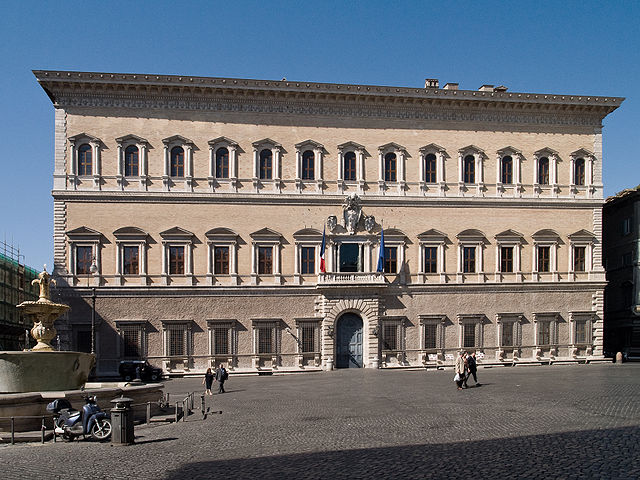
The رنسانس often refers to the رنسانس ایتالیایی that began in the 14th century, but recent research has revealed the existence of similar movements around Europe before the 15th century; consequently, the term "Early Modern" has gained popularity in describing this cultural movement. This period of cultural rebirth is often credited with the restoration of scholarship in the Classical Antiquities and the absorption of new scientific and philosophical knowledge that fed the arts.
The development from Medieval architecture concerned the way هندسه mediated between the intangibility of light and the tangibility of the material as a way of relating divine creation to mortal existence. This relationship was changed in some measure by the invention of Perspective which brought a sense of infinity into the realm of human comprehension through the new representations of the horizon, evidenced in the expanses of space opened up in Renaissance painting, and helped shape new انسانگرایی thought.
Perspective represented a new understanding of space as a universal, a priori fact, understood and controllable through human reason. Renaissance buildings therefore show a different sense of conceptual clarity, where spaces were designed to be understood in their entirety from a specific fixed viewpoint. The power of Perspective to universally represent reality was not limited to describing experiences, but also allowed it to anticipate experience itself by projecting the image back into reality.
The Renaissance spread to France in the late 15th century, when شارل هشتم returned in 1496 with several Italian artists from his conquest of Naples. Renaissance chateaux were built in the Loire Valley, the earliest example being the Château d'Amboise, and the style became dominant under فرانسوای اول (1515–47). (See Châteaux of the Loire Valley). The Château de Chambord is a combination of Gothic structure and Italianate ornament, a style which progressed under architects such as Sebastiano Serlio, who was engaged after 1540 in work at the Château de Fontainebleau.
Architects such as Philibert Delorme, Androuet du Cerceau, Giacomo Vignola, and Pierre Lescot, were inspired by the new ideas. The southwest interior facade of the Cour Carree of the موزه لوور in Paris was designed by Lescot and covered with exterior carvings by Jean Goujon. Architecture continued to thrive in the reigns of Henri II and Henri III.
In England the first great exponent of Renaissance architecture was Inigo Jones (1573–1652), who had studied architecture in Italy where the influence of آندرا پالادیو was very strong. Jones returned to England full of enthusiasm for the new movement and immediately began to design such buildings as the Queen's House at Greenwich in 1616 and the Banqueting House at Whitehall three years later. These works with their clean lines and symmetry, were revolutionary in a country still enamoured with mullion windows, crenellations and turrets.
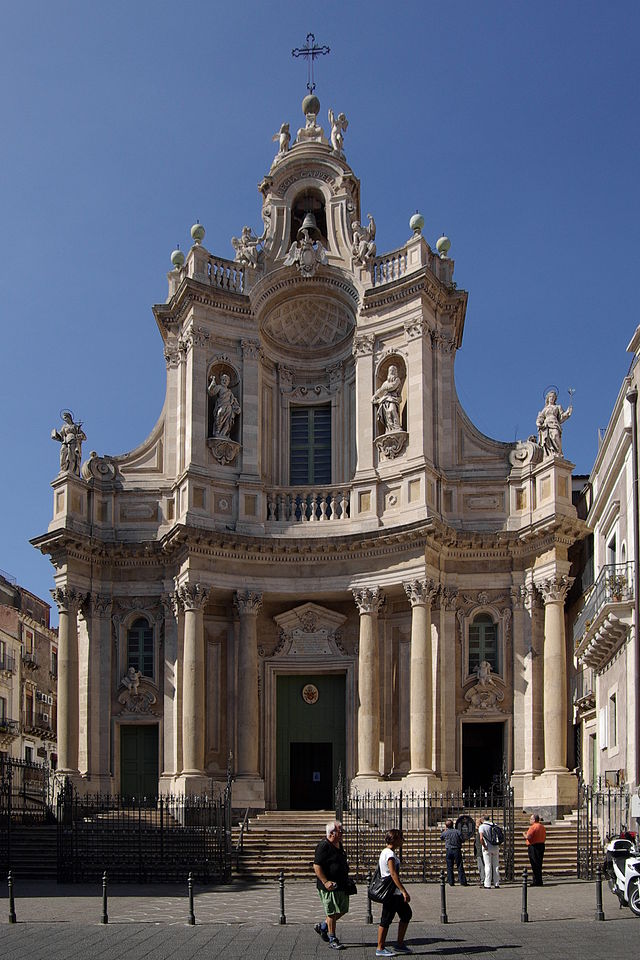
With the rise of various European colonial empires from the 16th century onward through the early 20th century, the new stylistic trends of Europe were exported to or adopted by locations around the world, often evolving into new regional variations.
Baroque architecture
The periods of شیوهگرایی and the باروک that followed the Renaissance signaled an increasing anxiety over meaning and representation. Important developments in science and philosophy had separated mathematical representations of reality from the rest of culture, fundamentally changing the way humans related to their world through architecture.[نیازمند منبع] It would reach its most extreme and embellished development under the decorative tastes of روکوکو.

Return to Classicism
In the late 17th and 18th centuries, the works and theories of آندرا پالادیو (from 16th century Venice) would again be interpreted and adopted in England, spread by the English translation of his I Quattro Libri dell'Architettura, and pattern books such as Vitruvius Brittanicus by Colen Campbell. This Palladian Architecture and continued classical imagery would in turn go on to influence توماس جفرسون and other early architects of the United States in their search for a new national architecture.
By the mid-18th century, there tended to be more restrained decoration and usage of authentic classical forms than in the Baroque, informed by increased visitation to classical ruins as part of the Grand Tour, coupled with the excavations of پمپئی and هرکولانیوم.
Revivalism and Orientalism
"What Style Shall We Build In?" - Heinrich Huebsch.
این بخش مقاله نیازمند گسترش است. |
The 19th Century was dominated by a wide variety of stylistic revivals, variations, and interpretations.
Beaux-Arts architecture

Beaux-Arts architecture[11] denotes the academic classical سبک معماری that was taught at the École des Beaux Arts in Paris. The style "Beaux-Arts" is above all the cumulative product of two and a half centuries of instruction under the authority, first of the Académie royale d'architecture, then, following the Revolution, of the Architecture section of the Académie des Beaux-Arts. The organization under the Ancien Régime of the competition for the Grand Prix de Rome in architecture, offering a chance to study in Rome, imprinted its codes and esthetic on the course of instruction, which culminated during the Second Empire (1850–1870) and the Third Republic that followed. The style of instruction that produced Beaux-Arts architecture continued without a major renovation until 1968.[12]
Art Nouveau
Around 1900 a number of architects around the world began developing new architectural solutions to integrate traditional precedents with new social demands and technological possibilities. The work of Victor Horta and Henry van de Velde in Brussels, آنتونی گائودی in Barcelona, Otto Wagner in Vienna and Charles Rennie Mackintosh in Glasgow, among many others, can be seen as a common struggle between old and new.
Early Modern architecture began with a number of building styles with similar characteristics, primarily the simplification of form and the elimination of ornament, that first arose around 1900. By the 1940s these styles had largely consolidated and been identified as the International Style.
The exact characteristics and origins of modern architecture are still open to interpretation and debate. An important trigger appears to have been the maxim credited to لوئیس سالیوان: "form follows function". Functionalism, in architecture, is the principle that architects should design a building based on the purpose of that building. This statement is less self-evident than it first appears, and is a matter of confusion and controversy within the profession, particularly in regard to معماری مدرن.
Expressionist architecture

Expressionist architecture was an architectural movement that developed in Northern Europe during the first decades of the 20th century in parallel with the هیجاننمایی visual and performing arts.
The style was characterised by an early-معماری مدرن adoption of novel materials, formal innovation, and very unusual massing, sometimes inspired by natural biomorphic forms, sometimes by the new technical possibilities offered by the mass production of brick, steel and especially glass. Many expressionist architects fought in World War I and their experiences, combined with the political turmoil and social upheaval that followed the انقلاب آلمان of 1919, resulted in a utopian outlook and a romantic socialist agenda.[13] Economic conditions severely limited the number of built commissions between 1914 and the mid 1920s,[14] resulting in many of the most important expressionist works remaining as projects on paper, such as Bruno Taut's Alpine Architecture and Hermann Finsterlin's Formspiels. Ephemeral exhibition buildings were numerous and highly significant during this period. Scenography for theatre and films provided another outlet for the expressionist imagination,[15] and provided supplemental incomes for designers attempting to challenge conventions in a harsh economic climate.
Art Deco
این بخش مقاله نیازمند گسترش است. |
International Style

The International style was a major سبک معماری of the 1920s and 1930s. The term usually refers to the buildings and architects of the formative decades of modernism, before World War II. The term had its origin from the name of a book by Henry-Russell Hitchcock and فیلیپ جانسون which identified, categorised and expanded upon characteristics common to modernism across the world. As a result, the focus was more on the stylistic aspects of modernism. The basic design principles of the International Style thus constitute part of نوگرایی.
The ideas of Modernism were developed especially in what was taught at the German باوهاوس School in وایمار (from 1919), Dessau (between 1926–32) and finally برلین between 1932–33, under the leadership first of its founder والتر گروپیوس, then هانس مایر, and finally لودویگ میس فن در روهه. Modernist theory in architecture resided in the attempt to bypass the question of what سبک معماری a building should be built in, a concern that had overshadowed 19th-century architecture, and the wish to reduce form to its most minimal expression of structure and function. In the ایالات متحده آمریکا, فیلیپ جانسون and Henry-Russell Hitchcock treated this new phenomenon in 1931 as if it represented a new style - the International Style, thereby misrepresenting its primary mission as merely a matter of eliminating traditional ornament. The core effort to pursue Modern architecture as an abstract, scientific programme was more faithfully carried forward in اروپا, but issues of style always overshadowed its stricter and more puritan goals, not least in the work of لوکوربوزیه.
Modern architecture
Modern architecture is generally characterized by simplification of form and creation of ornament from the structure and theme of the building. It is a term applied to an overarching movement, with its exact definition and scope varying widely.[16] Modern architecture has continued into the 21st century as a contemporary style, especially for corporate office buildings. In a broader sense, modern architecture began at the turn of the 20th century with efforts to reconcile the principles underlying architectural design with rapid technological advancement and the modernization of society. It would take the form of numerous movements, schools of design, and architectural styles, some in tension with one another, and often equally defying such classification.[16]
Critical regionalism

Critical regionalism is an approach to architecture that strives to counter the placelessness and lack of meaning in معماری مدرن by using contextual forces to give a sense of place and meaning. The term critical regionalism was first used by Alexander Tzonis and Liane Lefaivre and later more famously by Kenneth Frampton.
Frampton put forth his views in "Towards a Critical Regionalism: Six points of an architecture of resistance." He evokes پل ریکور's question of "how to become modern and to return to sources; how to revive an old, dormant civilization and take part in universal civilization". According to Frampton, critical regionalism should adopt modern architecture critically for its universal progressive qualities but at the same time should value responses particular to the context. Emphasis should be on topography, climate, light, tectonic form rather than scenography and the tactile sense rather than the visual. Frampton draws from phenomenology to supplement his arguments.
Postmodern architecture

Postmodern architecture is an international style whose first examples are generally cited as being from the 1950s, and which continues to influence present-day architecture. پستمدرنیته in architecture is generally thought to be heralded by the return of "wit, ornament and reference" to architecture in response to the formalism of the International Style of modernism. As with many cultural movements, some of postmodernism's most pronounced and visible ideas can be seen in architecture. The functional and formalized shapes and spaces of the نوگرایی movement are replaced by unapologetically diverse زیباییشناسی: styles collide, form is adopted for its own sake, and new ways of viewing familiar styles and space abound.
Classic examples of معماری مدرن are the Lever House and the Seagram Building in commercial space, and the architecture of فرانک لوید رایت or the باوهاوس movement in private or communal spaces. Transitional examples of postmodern architecture are the Portland Building in پورتلند، اورگن and the Sony Building (New York City) (originally AT&T Building) in New York City, which borrows elements and references from the past and reintroduces color and symbolism to architecture. A prime example of inspiration for postmodern architecture lies along the نوار لاس وگاس, which was studied by رابرت ونچوری in his 1972 book Learning from Las Vegas celebrating the strip's ordinary and common architecture. Venturi opined that "Less is a bore", inverting لودویگ میس فن در روهه's dictum that "Less is more".
Deconstructivist architecture
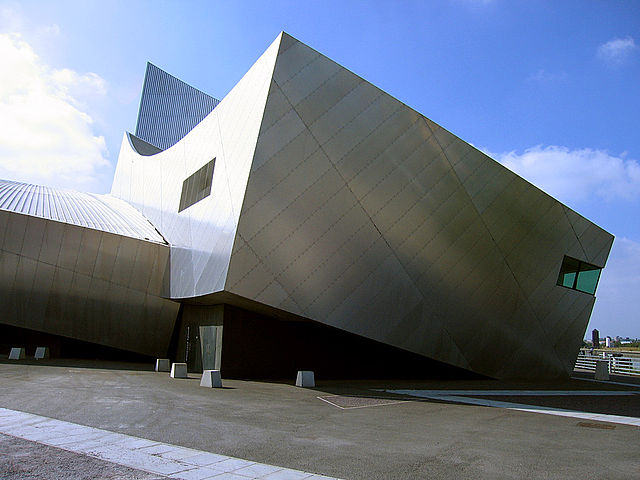
Deconstructivism in architecture is a development of معماری پستمدرن that began in the late 1980s. It is characterized by ideas of fragmentation, non-linear processes of design, an interest in manipulating ideas of a structure's surface or skin, and apparent هندسه نااقلیدسی,[17] (i.e., non-rectilinear shapes) which serve to distort and dislocate some of the elements of architecture, such as structure and envelope. The finished visual appearance of buildings that exhibit the many deconstructivist "styles" is characterised by a stimulating unpredictability and a controlled chaos.
Important events in the history of the deconstructivist movement include the 1982 پارک دو-له-وییت architectural design competition (especially the entry from ژاک دریدا and پیتر آیزنمان[18] and Bernard Tschumi's winning entry), the موزه هنر مدرن's 1988 Deconstructivist Architecture exhibition in New York, organized by فیلیپ جانسون and Mark Wigley, and the 1989 opening of the Wexner Center for the Arts in کلمبوس, designed by Peter Eisenman. The New York exhibition featured works by فرانک گری, Daniel Libeskind, رم کولهاس, پیتر آیزنمان, زها حدید, کپ هیملبلاو, and Bernard Tschumi. Since the exhibition, many of the architects who were associated with Deconstructivism have distanced themselves from the term. Nonetheless, the term has stuck and has now, in fact, come to embrace a general trend within contemporary architecture.
- Outline of architecture
- معماری مذهبی
Wikiwand in your browser!
Seamless Wikipedia browsing. On steroids.
Every time you click a link to Wikipedia, Wiktionary or Wikiquote in your browser's search results, it will show the modern Wikiwand interface.
Wikiwand extension is a five stars, simple, with minimum permission required to keep your browsing private, safe and transparent.


